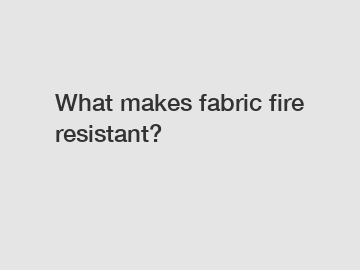What makes fabric fire resistant?
What Makes Fabric Fire-Resistant?
Fire accidents can be devastating, causing loss of life and property. To measure up to the challenges brought upon us by fire hazards, many industries have turned to developing fire-resistant fabrics. These fabrics provide an added layer of protection against flames, and their ability to withstand high temperatures has made them highly sought after in various fields. In this article, we will explore what makes fabric fire-resistant and understand how these materials work to protect us.
The Chemistry of Fire-Resistant Fabrics:

1. Flame retardant chemicals:
One of the primary factors that contribute to the fire resistance of fabrics is the application of flame retardant chemicals. These chemicals work by inhibiting or suppressing the combustion process when exposed to fire. Commonly used flame retardants include phosphorus-based compounds, brominated compounds, and nitrogen-containing compounds. These chemicals are either applied directly to the fabric or incorporated into the fabric during production.
2. Char formation:
Fire-resistant fabrics often undergo a process called char formation. When exposed to heat, these fabrics develop a char layer that acts as a barrier between the source of fire and the fabric itself. This char layer is formed as a result of a chemical reaction where the fabric undergoes thermal degradation, releasing gases that help create a protective carbonaceous layer.
3. Thermal insulation:
Another aspect of fire-resistant fabrics is their ability to provide thermal insulation. When exposed to high temperatures, these fabrics shrink and become denser, limiting the oxygen supply to the flames. This lack of oxygen restricts the spread of fire and reduces the likelihood of ignition.
The Role of Fabric Structure in Fire Resistance:
1. Tight weave and high thread count:
Fabrics with tightly woven structures and a high thread count tend to exhibit better fire resistance. A tight weave limits the amount of oxygen available within the fabric, reducing the potential for combustion. Additionally, a high thread count creates more surface area, allowing for better char formation and improved insulation.
2. Integration of synthetic fibers:
Fabrics containing synthetic fibers, such as polyester or nylon, often possess enhanced fire resistance. Synthetic fibers have inherent fire-resistant properties, as they do not readily ignite and tend to melt rather than burn. The melting behavior of these fibers creates a physical barrier, preventing the fire from spreading.
3. Specialized coatings and finishes:
Manufacturers often apply specialized coatings or finishes to fabrics to increase their fire resistance. These coatings can enhance the fabric's resistance to ignition, inhibit flame spread, and provide an additional layer of insulation. Silicon-based coatings, for example, can form a protective layer that prevents heat transfer.
Conclusion:
In summary, fire-resistant fabrics provide a crucial layer of protection against fire accidents. The combination of flame retardant chemicals, char formation, and thermal insulation allows these fabrics to withstand high temperatures and reduce the spread of flames. Fabric structure, integration of synthetic fibers, and the use of specialized coatings also play a vital role in enhancing fire resistance. By understanding what makes fabric fire-resistant, we can ensure the safety of individuals in various industries, including firefighting, aerospace, and military. For more information on fire-resistant fabrics, please feel free to contact us.
Contact Us:
If you are looking for more information on fire-resistant fabrics or wish to explore our range of products, please do not hesitate to contact us. We are here to answer any questions or inquiries you may have.
If you want to learn more, please visit our website cotton fire resistant, is denim flame resistant, cvc fabric composition.
67
0
0

Comments
All Comments (0)